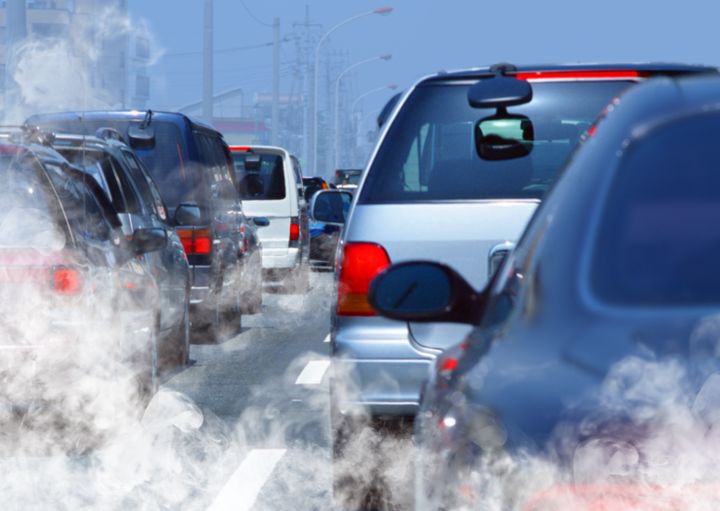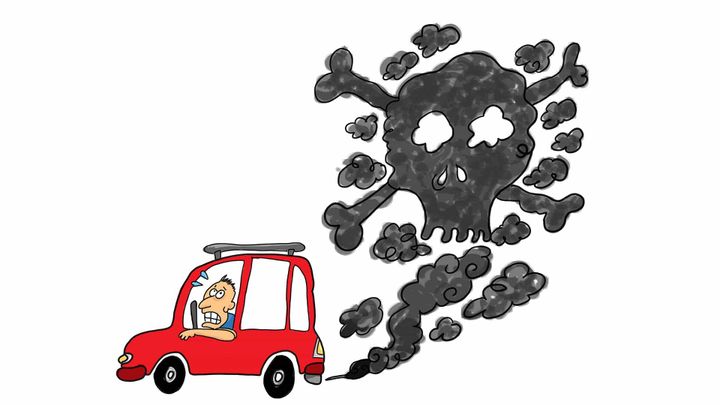


Air pollution from vehicles is a pressing environmental concern that affects the quality of air we breathe and contributes to climate change. Cars, particularly those powered by gasoline and diesel, emit a range of harmful pollutants that not only harm the environment but also pose serious risks to human health. This comprehensive guide explores practical solutions to reduce air pollution from cars, involving individual actions, technological advancements, government policies, and community efforts. By adopting sustainable transportation choices and embracing cleaner alternatives, we can mitigate the harmful effects of car emissions and create a greener future for our planet.

The primary source of air pollution from cars is the combustion of fossil fuels, such as gasoline and diesel. During this process, various pollutants are released into the atmosphere through the vehicle's exhaust system. The table below outlines the major pollutants emitted by cars and their potential impacts:
| Pollutant | Description | Potential Impacts |
|---|---|---|
| Carbon Dioxide (CO2) | A greenhouse gas | Contributes to climate change, global warming |
| Nitrogen Oxides (NOx) | Reactive gases | Respiratory problems, acid rain, ground-level ozone formation |
| Particulate Matter (PM) | Microscopic solid or liquid particles | Respiratory issues, lung cancer, heart disease |
| Volatile Organic Compounds (VOCs) | Organic chemicals | Ground-level ozone formation, respiratory irritation |
Additionally, evaporative emissions from fuel tanks and systems can contribute to air pollution, particularly in older vehicles or those with faulty emission control systems. These emissions occur when fuel vapors escape into the atmosphere, adding to the overall pollution levels.
Air pollution from cars has far-reaching consequences for both the environment and public health. Fossil fuel combustion in vehicles releases greenhouse gases, primarily carbon dioxide, which trap heat in the atmosphere and contribute to global warming and climate change. This can lead to rising sea levels, extreme weather events, and disruptions to ecosystems.
Furthermore, the pollutants emitted by cars can have severe health implications. Nitrogen oxides and particulate matter can cause respiratory problems, exacerbate conditions like asthma, and increase the risk of lung cancer. Volatile organic compounds can also contribute to the formation of ground-level ozone, which can irritate the eyes, nose, and throat, and potentially lead to long-term respiratory issues.
While addressing air pollution from cars requires a collective effort, individual actions can play a significant role in reducing emissions and promoting a cleaner environment.
One of the most effective ways to reduce car emissions is to drive less and opt for alternative transportation modes whenever possible. These modes include:
Walking
Cycling
Public transportation (buses, trains, subways)
Using alternative transportation not only decreases the number of vehicles on the road, thereby reducing overall emissions, but also promotes a healthier lifestyle and alleviates traffic congestion.
Regular vehicle maintenance is crucial for improving fuel efficiency and reducing emissions. Simple tasks like tune-ups, oil changes, and tire pressure checks can ensure that your vehicle operates at optimal levels, consuming less fuel and emitting fewer pollutants. Properly maintained vehicles emit fewer harmful emissions and can contribute to a cleaner air quality.
The table below highlights the benefits of regular vehicle maintenance:
| Maintenance Task | Benefit |
|---|---|
| Tune-ups | Improve engine performance, reduce emissions |
| Oil changes | Ensure proper lubrication, prevent excess fuel consumption |
| Tire pressure checks | Maintain optimal tire pressure for better fuel efficiency |
When purchasing a new vehicle, consider fuel-efficient models or electric vehicles (EVs). Fuel-efficient vehicles consume less gasoline or diesel, resulting in lower emissions. EVs, on the other hand, produce zero direct emissions, making them an environmentally friendly choice, especially when powered by renewable energy sources like solar or wind.
The table below compares the emissions of different vehicle types:
| Vehicle Type | Emissions |
|---|---|
| Gasoline-powered | Emits CO2, NOx, PM, VOCs |
| Diesel-powered | Emits CO2, NOx, PM, VOCs (higher PM levels) |
| Hybrid | Reduced emissions compared to gasoline-powered |
| Electric | Zero direct emissions |
Technological advancements play a pivotal role in reducing air pollution from cars by offering cleaner alternatives and improving emission control systems.
The development of electric vehicles (EVs) and hybrid vehicles has revolutionized the automotive industry, providing cleaner alternatives to traditional gasoline-powered vehicles.
Electric Vehicles (EVs): EVs run on electricity stored in rechargeable batteries and produce zero direct emissions, making them an attractive option for reducing air pollution in urban areas.
Hybrid Vehicles: Hybrid vehicles combine a gasoline engine with an electric motor, allowing them to operate on both fuel sources. This technology improves fuel efficiency and reduces emissions compared to conventional gasoline-powered vehicles.
Advancements in engine technology have led to improved fuel efficiency and reduced emissions. Modern engines are designed to burn fuel more efficiently, resulting in lower levels of pollutants being released into the atmosphere.
Additionally, emission control systems, such as catalytic converters and particulate filters, play a crucial role in mitigating vehicle emissions. These systems capture and neutralize harmful pollutants before they are released into the air, contributing to cleaner air quality.
The table below outlines the key emission control systems and their functions:
| Emission Control System | Function |
|---|---|
| Catalytic Converter | Converts harmful pollutants into less harmful substances |
| Particulate Filter | Captures and filters out particulate matter from exhaust |
| Exhaust Gas Recirculation (EGR) | Recirculates a portion of exhaust gases to reduce NOx emissions |
The development of alternative fuels, such as biofuels and hydrogen, offers promising solutions for reducing air pollution from cars.
Biofuels: Biofuels, derived from renewable sources like plant materials or waste, can be used as a substitute for gasoline or diesel, potentially reducing greenhouse gas emissions and dependence on fossil fuels.
Hydrogen Fuel Cell Vehicles: Hydrogen fuel cell vehicles use hydrogen as a fuel source and produce only water vapor as a byproduct. While still in the early stages of development, hydrogen fuel cell technology holds great potential for reducing air pollution from transportation.
Governments around the world have implemented various policies and regulations to address air pollution from cars, playing a crucial role in driving change and promoting cleaner transportation options.
Emission standards and testing procedures are essential tools used by governments to regulate vehicle emissions. These standards set limits on the permissible levels of pollutants that can be emitted by vehicles, ensuring that manufacturers produce cleaner and more efficient models.
Regular emission testing helps ensure that vehicles on the road comply with these standards, identifying and addressing any issues with emission control systems or excessive pollutant levels.

To encourage the adoption of cleaner vehicles, many governments offer incentives such as:
Tax credits
Rebates
Subsidies
These incentives can make cleaner transportation options more affordable and attractive, promoting a shift towards more sustainable mobility choices.
Governments can also play a role in reducing air pollution from cars by investing in public transportation systems and infrastructure.
Improving the accessibility, reliability, and convenience of public transportation can encourage more people to use these modes of transportation, reducing the number of cars on the road and their associated emissions.
Investments in infrastructure for alternative transportation modes, such as bike lanes and pedestrian-friendly urban planning, can further promote sustainable mobility choices and reduce reliance on personal vehicles.
While government policies and technological advancements are crucial, individual and community efforts also play a vital role in reducing air pollution from cars.
Carpooling and ride-sharing initiatives can significantly reduce the number of vehicles on the road by encouraging people to share rides. These programs not only reduce emissions but also alleviate traffic congestion and promote a sense of community.
Examples of carpooling and ride-sharing initiatives include:
Employer-sponsored carpooling programs
Community-based ride-sharing apps and platforms
Designated carpool lanes and parking incentives
Developing walkable and bike-friendly communities can encourage alternative modes of transportation and reduce reliance on personal vehicles. This can be achieved through urban planning initiatives that prioritize pedestrian and cycling infrastructure, such as:
Dedicated bike lanes
Pedestrian-friendly streets
Accessible public spaces
Bike-sharing programs
Communities can also support local policies and programs aimed at reducing car emissions. This may include:
Advocating for low-emission zones
Promoting public transportation initiatives
Participating in community-led campaigns to raise awareness about the importance of sustainable transportation choices
Supporting local initiatives that encourage walking, cycling, and the use of public transportation
Reducing air pollution from cars requires a collective effort from individuals, communities, governments, and the automotive industry. By adopting sustainable transportation choices, embracing technological innovations, and supporting effective policies and regulations, we can mitigate the harmful effects of car emissions on the environment and public health.
It is our shared responsibility to take action and make conscious choices for a cleaner and healthier future. Through a multi-faceted approach that addresses individual behaviors, technological advancements, government policies, and community initiatives, we can create a greener future where air pollution from cars is significantly reduced, and our cities and communities thrive in a cleaner, more sustainable environment.
The main pollutants emitted by vehicles include carbon dioxide (CO2), nitrogen oxides (NOx), particulate matter (PM), and volatile organic compounds (VOCs).
Vehicle emissions, particularly CO2, are a significant source of greenhouse gases that trap heat in the atmosphere and contribute to global warming and climate change.
Vehicle emissions can cause respiratory problems, exacerbate conditions like asthma, increase the risk of lung cancer and heart disease, and contribute to the formation of ground-level ozone which can irritate the eyes, nose, and throat.
Driving at moderate speeds, avoiding excessive idling, combining trips, and maintaining proper vehicle maintenance can help reduce fuel consumption and emissions.
Electric vehicles produce zero direct emissions when being driven, making them an environmentally friendly choice and helping to reduce local air pollution.
Emission control systems like catalytic converters and particulate filters capture and neutralize harmful pollutants before they are released into the air, contributing to cleaner air quality.
Government policies, such as emission standards, incentives for low-emission vehicles, and investments in public transportation and infrastructure, can drive the adoption of cleaner transportation options and reduce vehicle emissions.
Alternative fuels like biofuels and hydrogen fuel cells can potentially reduce greenhouse gas emissions and dependence on fossil fuels, leading to lower vehicle emissions.
Carpooling and ride-sharing initiatives can significantly reduce the number of vehicles on the road, thereby reducing overall emissions and alleviating traffic congestion.
Urban planning initiatives that prioritize pedestrian and cycling infrastructure, promote public transportation, and encourage walkable and bike-friendly communities can reduce reliance on personal vehicles and their associated emissions.

Sarah isn't your average gearhead. With a double major in Mechanical Engineering and Automotive Technology, she dived straight into the world of car repair. After 15 years of turning wrenches at dealerships and independent shops, Sarah joined MICDOT to share her expertise and passion for making cars run like new. Her in-depth knowledge and knack for explaining complex issues in simple terms make her a valuable asset to our team.





